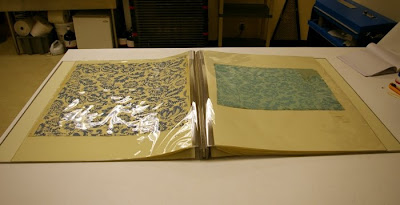I recently began a new project dealing with hand painted wallpaper samples from the late 19th century. There were twenty-eight samples in total, in a variety of sizes. All of them had been mounted to boards, but with two different adhesives. Some were attached to just a backing board with a gelatin paste, and others were matted and attached to a backing board with spray mount adhesive. There was also a variety of damage to the samples. ranging from creasing to tears to large sections missing. Because space in the lab was limited, I divided the samples into four groups (based on level of damage) so I could removed them from the stacks in smaller increments.The ultimate goal for these samples was to remove the acidic backing boards and line with Japanese tissue for stability, then construct a box to house the collection.
As previously stated, there were two distinctly different adhesives which led to two different methods of removing the board. Fortunately for those that were matted, the mat boards were cut larger than the backing board and taped together on the back. Because there was not adhesive between the sample and the mat, I was able to simply remove the tape on the back and thus remove the mat. I found a surprise in one of these worth photographing.

Because the spray mount adhesive was not water soluble, I had to remove the backing board dry. I did this using a shaped bone folder. I removed the board slowly, in layers. Luckily these boards split easily. I continued removing layers until I was as close as I could comfortably get to the paper. Some areas lifted clean away from the paper without fuss. For the areas where the board was well and truly stuck, I used the bone folder to gently scrape and the surface and thin the board down to the last layer before the paper, and left it. Forced removal would skin the paper. The following picture shows this process about halfway through, and the tool used.
When the backing board was sufficiently removed, I pasted out the wallpaper on a sheet of Mylar and lined it with Japanese tissue. I dried the samples between Reemay and blotting paper under weight to keep them flat.
I did have some minor issues on the first couple samples with skinning the paper. After I began to get the hang of it, I realized this was because I was trying to take off too much backing board at once. I also found that when I was down to the last few layers, the thinner I could get the board, the easier it came away from the paper.
In the next parts I will discuss my wet board removal method, and how I treated the missing pieces on damaged samples.












